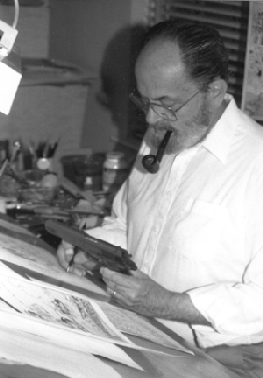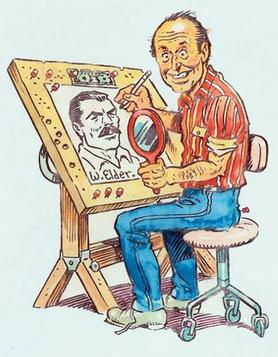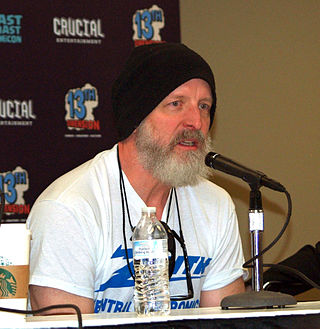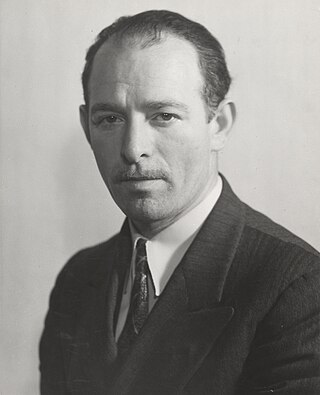Related Research Articles

Timely Comics is the common name for the group of corporations that was the earliest comic book arm of American publisher Martin Goodman, and the entity that would evolve by the 1960s to become Marvel Comics.

Harvey Kurtzman was an American cartoonist and editor. His best-known work includes writing and editing the parodic comic book Mad from 1952 until 1956, and writing the Little Annie Fanny strips in Playboy from 1962 until 1988. His work is noted for its satire and parody of popular culture, social critique, and attention to detail. Kurtzman's working method has been likened to that of an auteur, and he expected those who illustrated his stories to follow his layouts strictly.

Weirdo was a magazine-sized comics anthology created by Robert Crumb and published by Last Gasp from 1981 to 1993. Featuring cartoonists both new and old, Weirdo served as a "low art" counterpoint to its contemporary highbrow Raw, co-edited by Art Spiegelman.

John Powers Severin was an American comics artist noted for his distinctive work with EC Comics, primarily on the war comics Two-Fisted Tales and Frontline Combat; for Marvel Comics, especially its war and Western comics; and for his 45-year stint with the satiric magazine Cracked. He was one of the founding cartoonists of Mad in 1952.

William Elder was an American illustrator and comic book artist who worked in numerous areas of commercial art but is best known for a frantically funny cartoon style that helped launch Harvey Kurtzman's Mad comic book in 1952.

Kitchen Sink Press was a comic book publishing company founded by Denis Kitchen in 1970. Kitchen Sink Press was a pioneering publisher of underground comics, and was also responsible for numerous republications of classic comic strips in hardcover and softcover volumes. One of their best-known products was the first full reprint of Will Eisner's The Spirit—first in magazine format, then in standard comic book format. The company closed in 1999.

Little Annie Fanny is a comics series by Harvey Kurtzman and Will Elder. It appeared in 107 two- to seven-page episodes in Playboy magazine from October 1962 to September 1988. Little Annie Fanny is a humorous satire of contemporary American society and its sexual mores. Annie Fanny, the title character, is a statuesque, buxom young blonde woman who innocently finds herself nude in every episode. The series is notable for its painted, luminous color artwork and for being the first full-scale, multi-page comics feature in a major American publication.

William York Wray, known professionally as Bill Wray, is an American cartoonist, animator and landscape painter widely known for his contributions to Mad and The Ren & Stimpy Show, as well as his current focus on regional landscape painting—under the names Bill Wray for his animated work and William Wray for his paintings.

Humbug is a humor magazine published from 1957 to 1958. Edited by Harvey Kurtzman, the magazine took satirical jabs at movies, television, advertising and various artifacts of popular culture, from cereal boxes to fashion photographs. Nine of the eleven issues were published in a black-and-white comic book-sized format.

Pussycat is a fictional comic book character who originally appeared in black-and-white strips printed in men's magazines published by Magazine Management Company between 1965 and 1972. During this period Martin Goodman was publisher for both Magazine Management and Marvel Comics; as a result in 1968 a magazine format compilation of Pussycat's adventures was published as a one-off title, The Adventures of Pussycat.

Denis Kitchen is an American underground cartoonist, publisher, author, agent, and the founder of the Comic Book Legal Defense Fund.

Vincent Paul Waller is an American writer, storyboard artist, animator, and technical director. He has worked on several animated television shows and movies, the most notable ones being The Ren & Stimpy Show and SpongeBob SquarePants.

Tom Sito is an American animator, animation historian and teacher. He is currently a Professor at USC's School of Cinematic Arts in the Animation Division. In 1998, Sito was included by Animation Magazine in their list of the One Hundred Most Important People in Animation.

Comics journalism is a form of journalism that covers news or nonfiction events using the framework of comics, a combination of words and drawn images. Typically, sources are actual people featured in each story, and word balloons are actual quotes. The term "comics journalism" was coined by one of its most notable practitioners, Joe Sacco. Other terms for the practice include "graphic journalism," "comic strip journalism", "cartoon journalism", "cartoon reporting", "comics reportage", "journalistic comics", and "sketchbook reports".

Louis Goodman Ferstadt was an American muralist and comics artist.

Harvey Kurtzman's Jungle Book is a graphic novel by American cartoonist Harvey Kurtzman, published in 1959. Kurtzman aimed it at an adult audience, in contrast to his earlier work for adolescents in periodicals such as Mad. The social satire in the book's four stories targets Peter Gunn-style private-detective shows, Westerns such as Gunsmoke, capitalist avarice in the publishing industry, Freudian pop psychology, and lynch-hungry yokels in the South. Kurtzman's character Goodman Beaver makes his first appearance in one of the stories.

Goodman Beaver is a fictional character who appears in comics created by American cartoonist Harvey Kurtzman. Goodman is a naive and optimistic Candide-like character, oblivious to the corruption and degeneration around him, and whose stories were vehicles for social satire and pop culture parody. Except for the character's first appearance, which Kurtzman did alone, the stories were written by Kurtzman and drawn by Will Elder.

American cartoonist Harvey Kurtzman was the founding editor and primary writer for the humor periodical Mad from its founding in 1952 until its 28th issue in 1956. Featuring pop-culture parodies and social satire, what began as a color comic book became a black-and-white magazine with its 24th issue.

Patsy Walker is a comic book title featuring the character Patsy Walker originally published by Timely Comics beginning in 1945, by Atlas Comics from 1951 to 1961, and later by Marvel Comics.
The New York Herald Tribune Syndicate was the syndication service of the New York Herald Tribune. Syndicating comic strips and newspaper columns, it operated from c. 1914 to 1966. The syndicate's most notable strips were Mr. and Mrs., Our Bill, Penny, Miss Peach, and B.C. Syndicated columns included Walter Lippmann's Today and Tomorrow, Weare Holbrook's Soundings, George Fielding Eliot's military affairs column, and John Crosby's radio and television column. Irita Bradford Van Doren was book review editor for a time.
References
- 1 2 Reynolds 1999, p. 54.
- 1 2 3 Kitchen & Buhle 2009, p. 22.
- ↑ Kitchen & Buhle 2009, p. 23.
Works cited
- Kitchen, Denis; Buhle, Paul (2009). The Art of Harvey Kurtzman: The Mad Genius of Comics. Harry N. Abrams. ISBN 978-0-8109-7296-4.
- Reynolds, Eric (February 1999). Spurgeon, Tom (ed.). "Hey Look! 1946–1949 Harvey Kurtzman". The Comics Journal . Fantagraphics Books (210): 54. ISSN 0194-7869.